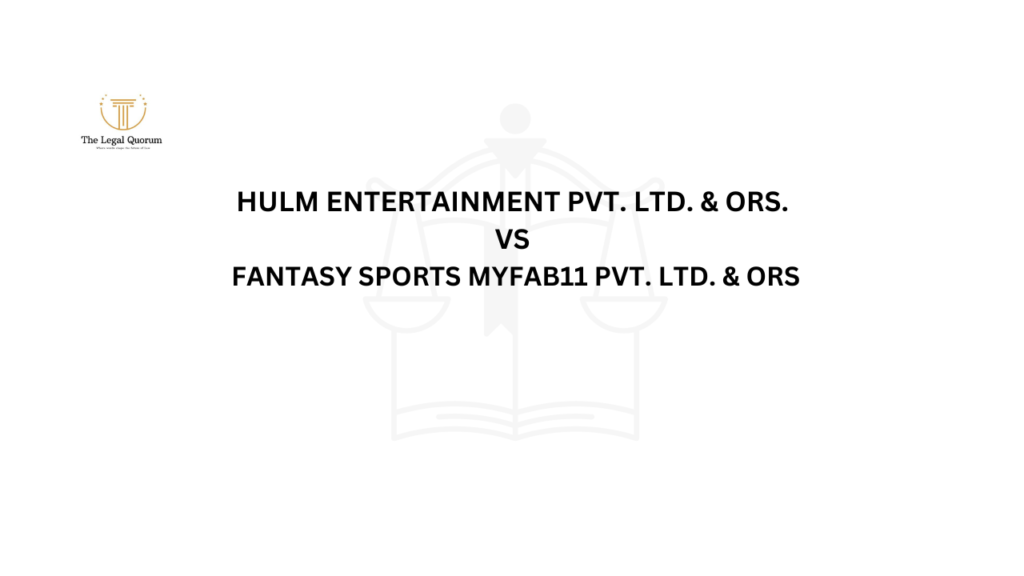Published on 05th July 2025
Authored By: Treasy Nilopher
Sastra Deemed University Tanjore
Court: Delhi High Court
Date of Judgment: December 26, 2024
Facts
The case revolves around Inter IKEA Systems B.V., the owner of the globally renowned “IKEA” trademark, which is protected under Indian trademark law. IKEA alleged that an Indian company had started using a deceptively similar mark – “IKEY” – for marketing furniture and home products, which are IKEA’s core goods.
Inter IKEA Systems B.V. asserted that “IKEY” was deliberately chosen to capitalize on IKEA’s goodwill, mislead consumers, and violate its exclusive rights. IKEA filed a suit in the Delhi High Court seeking an injunction, alleging trademark infringement, passing off, and unfair trade practices.
Issues Raised
The key issues before the Delhi High Court were:
- Whether the defendant’s use of the mark “IKEY” constituted trademark infringement under the Trade Marks Act, 1999.
- Whether the mark “IKEY” was deceptively similar to “IKEA” in terms of visual, phonetic, and structural characteristics.
- Whether there was a likelihood of consumer confusion or association between the two marks.
- Whether the defendant’s conduct amounted to passing off, thereby unjustly benefiting from IKEA’s brand reputation.
- Whether a permanent injunction should be granted to restrain the use of the impugned mark.
Contentions
Plaintiff (IKEA)
- IKEA argued that it enjoys a global reputation and its mark is a well-known trademark under Section 2(zg) of the Trade Marks Act, 1999.
- The mark “IKEA” has been registered in India since 1983 and covers a wide range of goods, including furniture, home accessories, and interior design products.
- IKEA claimed that the defendant deliberately adopted a confusingly similar mark “IKEY” to mislead customers, leveraging IKEA’s reputation.
- Phonetically and structurally, “IKEY” is deceptively similar to “IKEA”, especially considering both are four-letter words starting with “I” and ending with “E”.
- The similarity was not coincidental, as the defendant operated in the same industry and was marketing identical products like furniture.
- IKEA contended that this constituted trademark infringement (Section 29) and passing off, and prayed for a permanent injunction.
Defendant (IKEY)
- The defendant argued that “IKEY” was a coined term and not an imitation of “IKEA”.
- They denied bad faith and maintained that their brand was not intended to confuse or mislead customers.
- They contended that their marketing channels and branding strategies were distinct, and that any similarity was purely coincidental.
- They questioned IKEA’s claim of being a well-known mark in India, asserting that local consumer awareness of IKEA was limited at the time of their brand’s adoption.
- The defendant urged the Court to consider co-existence in the market and alleged that there was no actual consumer confusion.
Rationale
Justice C. Hari Shankar of the Delhi High Court meticulously assessed the legal and factual matrix, applying the principles of trademark law.
- Well-Known Trademark Recognition
The Court acknowledged that “IKEA” is a globally recognized trademark, enjoying trans-border reputation. The Court emphasized that a well-known mark enjoys enhanced protection, even in markets where it may not have a significant physical presence, as long as brand recognition exists.
- Test of Similarity
The Court applied the triple identity test and the test of deceptive similarity, considering:
Phonetic similarity – “IKEA” and “IKEY” sound alike when spoken aloud.
- Structural similarity – Both are four-letter words with a similar visual pattern.
- Conceptual similarity – Both are linked to furniture and home décor.
The Court ruled that the similarities could easily lead to consumer confusion, particularly among customers shopping online, where purchase decisions are often made quickly and based on visual cues.
- Bad Faith and Intention
The defendant’s choice of name, despite existing IKEA branding and the similarity in product range, was deemed to be not bona fide. The Court noted that while a company may independently coin a name, it cannot do so at the cost of consumer deception or by leveraging another’s goodwill.
- Likelihood of Confusion
The Court highlighted that actual confusion need not be proven—likelihood is sufficient under Indian trademark law. The existence of market overlap, combined with similarity in branding, created a high likelihood of association in consumers’ minds.
- Passing Off
Applying the classical trinity test of goodwill, misrepresentation, and damage, the Court held that:
- IKEA had a longstanding goodwill in the market.
- “IKEY” misrepresented itself as being associated or affiliated with IKEA.
This caused commercial harm to IKEA by diluting its brand distinctiveness.
- Permanent Injunction
The Court found that the balance of convenience favored IKEA and the brand faced irreparable harm without an injunction. As a result, a permanent injunction was granted restraining the defendant from using “IKEY” or any mark deceptively similar to “IKEA.”
Defects of Law
While the judgment robustly applies Indian trademark jurisprudence, it also reveals areas where legislative or judicial reform may be necessary:
- Lack of Uniform Definition for “Deceptive Similarity”
- Courts currently rely on subjective interpretation and the facts of each case.
- A more codified test under the Trade Marks Act could reduce ambiguity and create consistency in trademark decisions.
- Ambiguity in Trans-Border Reputation Standards
- Although trans-border reputation is recognized, the quantum of evidence required for a foreign brand to establish local recognition remains unclear.
- Clearer guidelines or presumptions for globally dominant brands could streamline litigation.
- Consumer Survey Evidence
The Indian legal framework does not mandate or standardize the use of consumer surveys to prove confusion.
- A more structured framework could help objectively assess actual vs. likely confusion.
- Penalties for Malicious Use
- There are limited deterrents against defendants who repeatedly or knowingly infringe well-known trademarks.
- Introducing statutory damages or higher penalties could reduce frivolous infringement and protect brand owners.
Inference
This decision underscores the strong judicial protection for well-known trademarks in India and reflects the growing sophistication of Indian IP jurisprudence, especially in the digital and e-commerce era.
The Court rightly recognized that brand reputation transcends borders and held that digital presence and recognition among Indian consumers are adequate to seek protection, even in the absence of a physical store in every region. The judgment also affirms that the intent of the infringer, especially when seen as an opportunistic move, plays a crucial role in deciding such cases.
From a broader perspective, the IKEA case sends a clear message to businesses: innovative branding must respect IP rights. The decision also benefits Indian consumers by ensuring clarity and authenticity in product sourcing.
Impact on Future Cases
This case sets a precedent for stricter enforcement of trademark laws and may be invoked in future disputes involving:
- Phonetically similar brands in the same or allied industries.
- International companies asserting trademark rights in India.
- Digital brand confusion, especially on e-commerce platforms or social media.
Legal Takeaway for Businesses
- Conduct trademark clearance searches before launching a brand.
- Avoid names that are even remotely similar to well-known marks, especially in overlapping sectors.
- Understand that even online-only brand presence can result in actionable infringement
References
[1] https://www.scconline.com/blog/post/2024/12/26/delhi-high-court-ikea-trademark-infringement-injunction-l egal-news/



